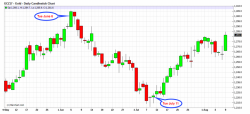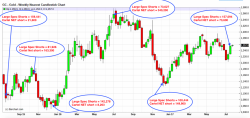While we've all noticed some of the extreme and historic changes to the Commitment of Traders report over the past two months, the once/month Bank Participation Report belies the fact that nothing has yet changed. Whenever price rallies, The Banks are still quick to take the short side of the trade.
First, we should probably begin this post with the usual background and disclaimer:
We've written about these CFTC-generated reports so many times, it would be impossible to link every post. However, nearly every post began with these bullet points. Here they are again, just so that we're on the same page:
- The CFTC's Bank Participation Report is issued monthly from a survey taken at the Comex close on the first Tuesday of every month. The report summarizes the combined positions of the four largest U.S. banks (primarily JPM, MorganStanley, Citi, Goldman but occasionally others) and the twenty largest non-U.S. banks (Scotia, HSBC, DeutscheBank, UBS, Barclays and others).
- Always keep in mind that these reports might be utter nonsense and complete falsifications, designed to mislead you and get you leaning the wrong way. In 2014, JPMorgan was fined by the CFTC for "repeatedly submitting inaccurate reports relating to the required reporting of positions". See here: https://www.cftc.gov/PressRoom/PressReleases/pr6968-14
Again, we know that what The Banks report as their "positions" provides an incomplete picture at best. Not only do The Banks maintain considerable long and short bets in the OTC market, they also operate numerous, offshore hedge funds and utilize these funds to take positions not included in the CFTC data as "commercial". So, what good are these reports? Similar to the weekly Commitment of Traders reports, the Bank Participation Report is only useful/interesting when considered historically...and that's what we'll do again today.
OK, with that said, let's take a look at the latest report that was surveyed on Tuesday, August 1 and released late last Friday, August 4.
If you've followed along for any length of time, then you know how The Banks make a market on the Comex. Once upon a time, The Banks operated as agents for the miners. The mining companies would hedge and/or sell forward their future production and would do so by having the agent Banks issue contracts on the Comex. The miner, through The Bank, would be on the short side of the trade and a speculator would bet on the long side. This is largely how the commodity markets functioned since they were first created.
However, over the past two decades, the amount of mining company hedging has declined to nearly zero. The most recent estimate we've seen showed only a total of about 270 mts of production in 2016 (https://www.reuters.com/article/us-gold-hedging-idUSKCN0ZS02B). Even if ALL of this hedging occurred on the Comex, this would only represent a need for about 87,000 contracts of open interest. However, we all know that total Comex gold open interest routinely averages in the 450,000-500,000 contract range. Thus the difference between 87,000 and current open interest is simple Bank speculation.
Again, we can't attribute EVERYTHING to the Comex and surely some of the stated Bank Comex positions are offset with other positions in London and on the opaque OTC "markets". However, when we consider the history of the Bank Participation Report data, a clear trend emerges and its one that, unfortunately, is quite clearly still present today.
I suppose that the best ting we can do is give you the data. In doing so, you should be quickly able to discern for yourself how this works:
1/5/16 @$1078 GROSS LONG GROSS SHORT TOTAL NET
US Banks 6,387 49,447 -43,060
Non-US Banks 35,499 37,698 -2,199
TOTAL -45,259
2/2/16 @$1127 GROSS LONG GROSS SHORT TOTAL NET
US Banks 9,136 54,150 -45,014
Non-US Banks 22,313 42,663 -20,350
TOTAL -65,364
3/1/16 @$1231 GROSS LONG GROSS SHORT TOTAL NET
US Banks 8,183 81,050 -72,867
Non-US Banks 20,514 72,777 -52,263
TOTAL -125,130
4/5/16 @$1230 GROSS LONG GROSS SHORT TOTAL NET
US Banks 11,099 88,208 -77,109
Non-US Banks 22,788 93,900 -71,112
TOTAL -148,221
5/3/16 @$1292 GROSS LONG GROSS SHORT TOTAL NET
US Banks 10,791 118,437 -107,646
Non-US Banks 21,905 109,511 -87,606
TOTAL -195,262
6/7/16 @$1247 GROSS LONG GROSS SHORT TOTAL NET
US Banks 12,704 73,928 -61,224
Non-US Banks 21,004 93,076 -72,072
TOTAL -133,296
7/5/16 @$1359 GROSS LONG GROSS SHORT TOTAL NET
US Banks 9,314 102,684 -93,370
Non-US Banks 14,622 113,086 -98,464
TOTAL -191,834
As price fell through the second half of 2016, Speculators dumped longs and The Banks used this selling to buy back and cover their short positions. By January of 2017, the BPR looked like this:
1/3/17 @$1162 GROSS LONG GROSS SHORT TOTAL NET
US Banks 11,393 60,352 -48,959
Non-US Banks 24,501 49,264 -24,763
TOTAL -73,722
As you know, price has rallied in 2017 is a sort of 3-steps-forward, 2-steps-back pattern. As you'd expect, the Bank positions reported via the BPR has ebbed and flowed, too. And by June, with price near its 2017 high (thus far), here's where the BPR stood:
6/6/17 @$1297 GROSS LONG GROSS SHORT TOTAL NET
US Banks 8,500 108,153 -99,653
Non-US Banks 20,128 96,962 -76,834
TOTAL -176,487
As you can see, The Banks were playing the same game in 2017 and they played in 2016, taking the short side of the trade versus the hedge fund and other Spec longs. In what should then come as no surprise at all, price was hammered lower over the course of the next five weeks, falling from $1297 on BPR survey date June 6 to $1215 on BPR survey date July 11.
At this point, the July BPR data was surveyed from the Commitment of Traders data taken that same afternoon. The CoT data was astounding, showing some of the lowest Speculator and Commercial positions since late 2015. It looked like this:
And the July BPR revealed this:
7/11/17 @$1215 GROSS LONG GROSS SHORT TOTAL NET
US Banks 14,013 78,063 -64,050
Non-US Banks 26,675 67,373 -40,698
TOTAL -104,748
Since the CoT and BPR had changed so dramatically in a month, there was hope across the gold blogosphere that maybe, just maybe:
- The Banks were moving to quickly cover shorts and get out of the manipulation business
- The Banks knew that the game was nearly over and they needed to act fast
- The Banks were fearful of Andrew Maguire's alleged 250 mt order and were desperate to reduce their potential short liability
- And so on and so forth
Instead, while price has rallied form those early July lows, the latest BPR reveals that nothing has changed at all. The Banks aren't afraid of anything. There's no banker blood in the streets. Instead, the data shows that they're still just playing the same old, tired game.
8/1/17 @$1270 GROSS LONG GROSS SHORT TOTAL NET
US Banks 9,767 103,249 -93,482
Non-US Banks 20,357 81,733 -61,376
TOTAL -154,858
So, The Banks used the latest 4.5% rally in price to increase their summary NET short position by nearly 50%. And again, this is not a sudden rush of mining companies beating down the Banker's doors in a desperate attempt to sell forward their remaining 2017 production. Instead, The Banks are simply once again playing their (profitable) game of supplying the paper derivatives to The Specs while using their infinitely deep pockets to wait them out until price can once again be rigged lower. Again, unlike what some had so fervently hoped back in July, nothing has changed. The Banks haven't changed course and they certainly aren't taking any preemptive measures against a sudden price "reset".
In the end, what does this mean? Business as usual, I guess. We'll continue to monitor the Bank and "Commercial" positions and look for buying/selling signals based upon historical references. And in the meantime, we'll have no illusions about who is really in charge of these fraudulent and manipulated paper metal "markets".
TF








